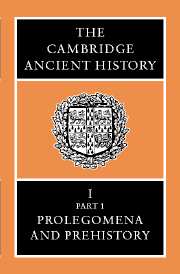Book contents
- Frontmatter
- Contents
- List of Maps
- List of Tables
- List of Text-figures
- Preface
- Chapter I The Geological Ages
- Chapter II Physical Conditions in Eastern Europe, Western Asia and Egypt Before the Period of Agricultural and Urban Settlement
- Chapter III Primitive Man in Egypt, Western Asia and Europe in Palaeolithic Times
- Chapter IV The Evidence of Language
- Chapter V The Earliest Populations of Man in Europe, Western Asia and Northern Africa
- Chapter VI Chronology
- Chapter VII (a) The Earliest Settlements in Western Asia from the Ninth to the End of the Fifth Millennium B.C.
- Chapter VII (b) Anatolia Before 4000 B.C.
- Chapter VIII The Development of Cities From Al-‘Ubaid to the End of Uruk 5
- Chapter IX (a) Predynastic Egypt
- Chapter IX (b) Palestine During the Neolithic and Chalcolithic Periods
- Chapter IX (c) Cyprus in the Neolithic and Chalcolithic Periods
- Chapter X The Stone Age in the Aegean
- Bibliographies
- Index to Maps
- General Index
- Maps
Chapter VIII - The Development of Cities From Al-‘Ubaid to the End of Uruk 5
Published online by Cambridge University Press: 28 March 2008
- Frontmatter
- Contents
- List of Maps
- List of Tables
- List of Text-figures
- Preface
- Chapter I The Geological Ages
- Chapter II Physical Conditions in Eastern Europe, Western Asia and Egypt Before the Period of Agricultural and Urban Settlement
- Chapter III Primitive Man in Egypt, Western Asia and Europe in Palaeolithic Times
- Chapter IV The Evidence of Language
- Chapter V The Earliest Populations of Man in Europe, Western Asia and Northern Africa
- Chapter VI Chronology
- Chapter VII (a) The Earliest Settlements in Western Asia from the Ninth to the End of the Fifth Millennium B.C.
- Chapter VII (b) Anatolia Before 4000 B.C.
- Chapter VIII The Development of Cities From Al-‘Ubaid to the End of Uruk 5
- Chapter IX (a) Predynastic Egypt
- Chapter IX (b) Palestine During the Neolithic and Chalcolithic Periods
- Chapter IX (c) Cyprus in the Neolithic and Chalcolithic Periods
- Chapter X The Stone Age in the Aegean
- Bibliographies
- Index to Maps
- General Index
- Maps
Summary
I. BABYLONIA AND MESOPOTAMIA
TERMINOLOGY
Al-‘Ubaid is a small site which lies about 4 miles west of Ur along the bank of an ancient canal. There, H. R. Hall and Leonard Woolley were the first to discover and record a prehistoric pottery, hand-turned and decorated with simple designs painted in a dark pigment on a comparatively light ground; the predominating colours were black, green, brown or chocolate on pink or buff and the pots were sometimes slipped, sometimes unslipped. Characteristic of these so called ‘Ubaid wares was a carbonized, dark green, highly vitrified paint which had bitten hard into the clay, the result of over-firing; in the later stages of development this criterion makes ‘Ubaid singularly easy to distinguish. When the excavations revealed that this was a prehistoric pottery, the term ‘Ubaid was applied to it and was also used to define the period and the culture with which it appeared to be distinctively associated.
After the excavations at the site of ‘Ubaid had been concluded, the same type of pottery was discovered in abundance at the neighbouring, and much greater, site of Ur. It soon began to be evident that this ware must have lasted for a long span of time, which Woolley consequently sub-divided into three periods. Later, however, when the Iraq Antiquities Department began to conduct excavations on a wide scale at the great site of Eridu, an even longer sequence, covering four successive periods, was established, and it became possible to classify this pottery into a number of dominant styles which had developed over a span of many centuries.
Deep down at the bottom of Eridu, the decorated pottery was given the name of Eridu ware (or ‘Ubaid 1), and this was succeeded by another variety, Qal’at Hajji Muhammad (or ‘Ubaid 2), named after a type site which is situated near to Warka, and this again was followed by two varieties of ‘Ubaid ware (‘Ubaid 3, 4), which in style came very close to that which had been found in abundance at Ur. Whether we should call the entire series by the generic name of ‘Ubaid is a matter for debate, but on the whole this distinctive and striking pottery does show a homogeneous development, and we may therefore accept the apparent continuity as indicative of a single consistent period of culture.
- Type
- Chapter
- Information
- The Cambridge Ancient History , pp. 327 - 462Publisher: Cambridge University PressPrint publication year: 1970

